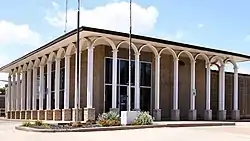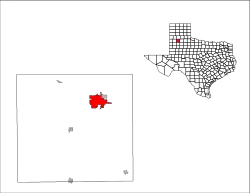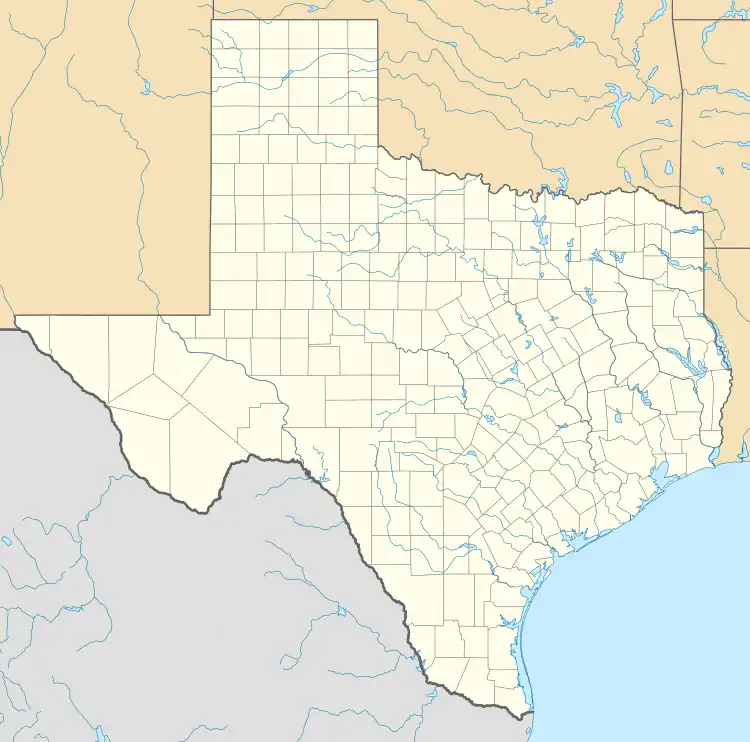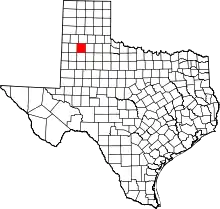Plainview, Texas
Plainview is a city in and the county seat of Hale County, Texas, United States.[5] As of the 2010 census, the population was 22,194.
Plainview, Texas | |
|---|---|
 Plainview City Hall | |
 | |
 Plainview  Plainview | |
| Coordinates: 34°11′28″N 101°43′8″W | |
| Country | |
| State | |
| County | Hale |
| Government | |
| • Type | Council-Manager |
| • City Council |
|
| • Mayor | Charles Starnes |
| • City Manager | Jeffrey Snyder |
| Area | |
| • Total | 13.89 sq mi (35.99 km2) |
| • Land | 13.89 sq mi (35.99 km2) |
| • Water | 0.00 sq mi (0.00 km2) |
| Elevation | 3,366 ft (1,026 m) |
| Population (2010) | |
| • Total | 22,194 |
| • Estimate (2019)[2] | 20,143 |
| • Density | 1,449.66/sq mi (559.72/km2) |
| Time zone | UTC-6 (Central (CST)) |
| • Summer (DST) | UTC-5 (CDT) |
| ZIP codes | 79072-79073 |
| Area code | 806 |
| FIPS code | 48-57980[3] |
| GNIS feature ID | 1365375[4] |
| Website | plainviewtx |
Geography
Plainview is located at 34°11′28″N 101°43′8″W (34.191204, –101.718806) and is located on the Llano Estacado.[6]
According to the United States Census Bureau, the city has a total area of 13.8 square miles (36 km2), all land.
Climate
According to the Köppen climate classification system, Plainview has a semiarid climate, BSk on climate maps.[7]
Demographics
| Census | Pop. | Note | %± |
|---|---|---|---|
| 1910 | 2,829 | — | |
| 1920 | 3,989 | 41.0% | |
| 1930 | 8,834 | 121.5% | |
| 1940 | 8,263 | −6.5% | |
| 1950 | 14,044 | 70.0% | |
| 1960 | 18,735 | 33.4% | |
| 1970 | 19,096 | 1.9% | |
| 1980 | 22,187 | 16.2% | |
| 1990 | 21,700 | −2.2% | |
| 2000 | 22,336 | 2.9% | |
| 2010 | 22,194 | −0.6% | |
| 2020 | 20,187 | −9.0% | |
| U.S. Decennial Census[8] | |||
2020 census
| Race | Number | Percentage |
|---|---|---|
| White (NH) | 5,579 | 27.64% |
| Black or African American (NH) | 934 | 4.63% |
| Native American or Alaska Native (NH) | 71 | 0.35% |
| Asian (NH) | 115 | 0.57% |
| Pacific Islander (NH) | 25 | 0.12% |
| Some Other Race (NH) | 40 | 0.2% |
| Mixed/Multi-Racial (NH) | 377 | 1.87% |
| Hispanic or Latino | 13,046 | 64.63% |
| Total | 20,187 |
As of the 2020 United States census, there were 20,187 people, 6,843 households, and 4,668 families residing in the city.
2000 census
As of the census of 2000, 22,336 people, 7,626 households, and 5,666 families resided in the city. The population density was 1,621.0 inhabitants per square mile (625.9/km2). The 8,471 housing units averaged 614.8/sq mi (237.4/km2). The racial makeup in the city was 63.21% White, 5.87% African American, 1.13% Native American, 0.43% Asian, 26.59% from other races, and 2.77% from two or more races. Hispanics or Latinos of any race were 49.83% of the population.
Of the 7,626 households, 40.1% had children under the age of 18 living with them, 57.2% were married couples living together, 13.0% had a female householder with no husband present, and 25.7% were not families. About 22.7% of all households were composed of single individuals, and 11.2% were households of persons 65 years of age or older living alone. The average household size was 2.82, and the average family size was four.
In the city, the population was distributed as 31.0% under the age of 18, 11.5% from 18 to 24, 26.0% from 25 to 44, 18.0% from 45 to 64, and 13.5% who were 65 years of age or older. The median age was 31 years. For every 100 females, there were 91.7 males. For every 100 females age 18 and over, there were 86.7 males.
The median income per household was $31,551, and per family was $35,215. Males had a median income of $26,434 versus $19,888 for females. The per capita income for the city was $13,791. About 15.0% of families and 19.1% of the population were below the poverty line, including 25.1% of those under age 18, and 14.8% of those aged 65 or over.
Economy
In 2009, the Texas Department of State Health Services ordered the recall of all products produced by a processing facility near Plainview owned by Peanut Corporation of America. Rodents, excrement, and feathers in the plant had been found in the facility's products. The closure was not related to closures of PCA plants due to Salmonella concerns.[12]
A Cargill beef processing plant, then the largest employer in the city, closed in 2013 due to lack of incoming animals, a result of the 2010–2012 drought. The closure created challenges for the city, as an estimated 2,300 employees and their families relocated.[13]
Government
The Texas Department of Criminal Justice Region V office is located in Plainview.[14] The current Region V headquarters opened in 1996 in a former Bank of America building.[15]
Education
The city is served by the Plainview Independent School District, which enrolled 5,585 students as of 2018.[16] The district attracts transfer students from surrounding school districts. Due to the PISD's size compared to surrounding districts, many of the district's schools provide extensive support for disabled students and students with special needs not available at other schools outside the district, in addition to more specialized courses. The mascot for the Plainview High School is a grey English Bulldog nicknamed "Big Red".[17]
Wayland Baptist University, a private, four-year, coeducational, Baptist university, is based in the city. In 1908, when the school was founded, the campus was more than a mile from the city limit. The Museum of the Llano Estacado, which opened in 1976, is located on the university grounds.[18] The museum is home to a permanent exhibit featuring artifacts from the Plainview Site, and fossilized remains of a Columbian mammoth known as the "Imperial Mammoth".[19]
An extension of South Plains College serves the residents of the city.
Media
The Plainview Herald, formerly the Plainview Daily Herald, is the city's only remaining newspaper. It was acquired from local owners by Hearst Communications in 1979. It is among the oldest newspapers in Texas still in publication, and became fully computer paginated in 1994, the same year it began publishing an online edition. Customers in the city are also served by the Lubbock Avalanche-Journal, which often reports on news from Plainview.
Eight radio stations broadcast from the city, including KVOP, among the oldest in the region. KVOP's call sign originally meant "Voice of Plainview".
The city is within the Lubbock television market. Due to the terrain, television stations based in Amarillo can be received over-the-air, either directly or via repeaters north of the city. Prior to 1993, virtually all stations broadcast from Lubbock and Amarillo markets were retransmitted by the local cable operator. After changes were made to must-carry rules by the Federal Communications Commission only stations from Lubbock are available to cable and digital satellite customers in the city.
The Steve Martin film Leap of Faith (1992) was filmed in and around Plainview. Several residents were hired as extras for the film. Until 2016, a water tower east of downtown bore the name and mascot of the fictional town on which the movie was set: Rustwater Bengals.
An episode of Vice portrayed the city as a ghost town in a documentary feature called "Deliver Us from Drought", despite 22,000 residents still living in the city at the time of filming.[20] The documentary featured numerous locations, many of which had been closed or abandoned for years prior, as examples of recent rural flight following a drought. The documentary followed the template of a similar short, "Dry and Drier in West Texas", which was broadcast on Showtime.[21] Both documentaries portrayed residents of the city as excessively religious.
Notable people
- James H. Clark, founder of Silicon Graphics, Netscape, and other companies
- Jimmy Dean, singer, actor, and entrepreneur, host of The Jimmy Dean Show
- Bob Dorough, bebop and cool jazz pianist
- Michael Egnew, former player for the Miami Dolphins
- Marshall Formby, a former county judge for Dickens County and a state senator
- Leonard Garcia, retired professional mixed martial artist.
- Todrick Hall, YouTube personality, singer, and Broadway actor
- Harry Igo, president of Plainsman Fertilizer Company, a division of W.R. Grace and Company. On July 26, 1945, Army Air Force Captain Igo and his crew transported parts of the Little Boy atomic bomb in a Douglas C-54 Skymaster cargo plane from Kirtland Air Force Base (Albuquerque, New Mexico) to Hamilton Army Airfield, California. Igo and his crew did not know the contents of their cargo until the National Archives revealed it years later.[22]
- Don January, professional golfer
- Jim Landtroop, former member of Texas House of Representatives
- Pete Laney, former speaker of the Texas House of Representatives
- Emily Jones McCoy, former reporter for KCBD and Fox Sports Networks
- Lawrence McCutcheon, former player for the Los Angeles Rams
- Carl Nafzger, Thoroughbred trainer of Derby winner Unbridled and 1990 Breeders' Cup
- Ray Poage, former player for the Minnesota Vikings
- Lavern Roach, professional boxer
- Mariel Salcedo, online video personality, podcast host, actress, and Producer for Rooster Teeth Productions[23][24][25]
- Julius Waring Walker, Jr., former U.S. Ambassador to Burkina Faso
- Jamar Wall, player with Calgary Stampeders (CFL)
- James Henry Wayland, physician, founder of Wayland Baptist University
References
- "2019 U.S. Gazetteer Files". United States Census Bureau. Retrieved August 7, 2020.
- "Population and Housing Unit Estimates". United States Census Bureau. May 24, 2020. Retrieved May 27, 2020.
- "U.S. Census website". United States Census Bureau. Retrieved January 31, 2008.
- "US Board on Geographic Names". United States Geological Survey. October 25, 2007. Retrieved January 31, 2008.
- "Find a County". National Association of Counties. Retrieved June 7, 2011.
- Geography, US Census Bureau (February 12, 2011). "U.S. Gazetteer: 2010, 2000, and 1990". www.census.gov. Retrieved April 23, 2011.
- "Plainview, Texas Köppen Climate Classification (Weatherbase)". Weatherbase. Retrieved December 22, 2018.
- "Census of Population and Housing". Census.gov. Retrieved June 4, 2015.
- "Explore Census Data". data.census.gov. Retrieved May 20, 2022.
- https://www.census.gov/
- "About the Hispanic Population and its Origin". www.census.gov. Retrieved May 18, 2022.
- "Dead rodents, excrement in peanut processor lead to recall - CNN.com". www.cnn.com. February 12, 2009. Retrieved December 22, 2018.
- Fernandez, Manny (February 27, 2013). "Drought Takes Its Toll on a Texas Business and a Town". The New York Times. ISSN 0362-4331. Retrieved February 28, 2013.
- "Region V Director's Office Archived 2009-07-05 at the Wayback Machine." Texas Department of Criminal Justice. Retrieved on January 2, 2010.
- "REGION FIVE PRISON HEADQUARTERS OPENS." Plainview Daily Herald. July 18, 1996. Retrieved on May 6, 2010. "The new headquarters' home is the former Bank of America building which was owned by the..."
- "District Overview / District Overview". www.plainviewisd.org. Retrieved December 22, 2018.
- "Plainview Bulldogs". kcbd.com. September 28, 2007. Retrieved December 22, 2018.
- Davis, Charles G. (June 15, 2010). "PLAINVIEW, TX". tshaonline.org. Retrieved December 22, 2018.
- "Imperial Mammoth". Plainview, TX. Retrieved December 22, 2018.
- Marquez, Homer (May 21, 2014). "2 new documentaries cite Plainview's plight". Plainview Daily Herald. Retrieved December 22, 2018.
- "Dry and Drier in West Texas – The Story Group". February 22, 2015. Retrieved December 22, 2018.
- "Harry Igo: An Inventory of His Papers, 1934-1994 and undated, at the Southwest Collection/Special Collections Library". Texas Archival Resources Online. Retrieved March 5, 2015.
- "Mariel Salcedo".
- "Mariel Salcedo".
- "Your Friendly Neighborhood Queer: Rooster Teeth's Mariel Salcedo". September 29, 2017.
